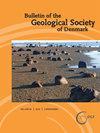丹麦Lillebælt粘土组始新世较长的鳗鱼(鳗形)
IF 1
4区 地球科学
Q2 Earth and Planetary Sciences
引用次数: 1
摘要
根据两个部分完整的关节颅骨骨骼,描述了一种来自日德兰半岛东部Trelde Næs暴露的Lillebælt粘土组下吕特期结核的同类鳗鱼(Anguilliformes,Congidae)。其中一个头骨标本显示了一个耳石空隙,Schwarzhans(2007)用它来描述已经灭绝的拟异尾海鳗,它被放在新属Smithconger gen.nov.Smithconger-treldensis(Schwarzhans2007)的特征是额侧突起发育良好,枕上嵴缺失,蝶棘相当大,向前突出并暴露在颅骨顶部的平坦表面上,耳大泡明显缩小,上颌骨几乎笔直且向远侧突出,上颌和齿状牙齿数量众多并排列成多排,齿状牙齿的腹侧轮廓略凸,操纵盖的后缘光滑,近鳍短。Smithconger treldeensis的耳石背缘高,背侧凹陷宽而深,无腹侧沟,沟直,浅,位于中央,有前减少的丘,丘前端的口通道短,未到达前边缘。来自新西兰Kaiatan(Bartonian/Priabonian)的以耳石为基础的物种Bathycongrus waihaoensis Schwarzhans,2019也被归入Smithconger属。Smithconger暂时被称为Congrinae亚科,因为舌骨条缺乏低透明质。这一新的始新世鳗鱼属与现存的巴萨纳戈鳗鱼有一定程度的相似性。文中还简要讨论了其他始新世星团的多样性及其相互关系。本文章由计算机程序翻译,如有差异,请以英文原文为准。
An Eocene conger eel (Teleostei, Anguilliformes) from the Lillebælt Clay Formation, Denmark
A conger eel (Anguilliformes, Congridae) is described from the lower Lutetian concretionary nodules of the Lillebælt Clay Formation exposed at Trelde Næs, eastern Jutland, based on two partially complete articulated cranial skeletons. One of the cranial specimens exhibits an otolith void from which a cast was taken, used by Schwarzhans (2007) to describe the extinct Pseudoxenomystax treldeensis, which is placed herein within the new genus Smithconger gen. nov. Smithconger treldeensis (Schwarzhans, 2007) is characterized by well-developed lateral processes on the frontals, supraoccipital crest absent, sphenotic spine rather large, anteriorly pointed and exposed on the flattened surface of the skull roof, otic bullae considerably reduced, maxilla almost straight and distally pointed, maxillary and dentary teeth numerous and arranged in multiple rows, dentary with slightly convex ventral profile, opercle with smooth posterior margin and subopercle short. The otoliths of Smithconger treldeensis show high dorsal rim, broad and deep dorsal depression, no ventral furrow, sulcus straight, shallow, centrally positioned with anteriorly reduced colliculum, and ostial channel at anterior tip of colliculum short, not reaching the predorsal rim. The otolith-based species Bathycongrus waihaoensis Schwarzhans, 2019 from the Kaiatan (Bartonian/Priabonian) of New Zealand is also assigned to the genus Smithconger. Smithconger is tentatively referred to the congrid subfamily Congrinae due to the lack of hypohyals in the hyoid bar. This new Eocene genus of conger eel shows a certain degree of similarity with the extant Bassanago. The diversity and relationships of other Eocene congrids is also briefly discussed.
求助全文
通过发布文献求助,成功后即可免费获取论文全文。
去求助
来源期刊

Bulletin of the Geological Society of Denmark
GEOSCIENCES, MULTIDISCIPLINARY-
CiteScore
2.80
自引率
16.70%
发文量
28
审稿时长
>12 weeks
期刊介绍:
The Bulletin publishes contributions of international interest in all fields of geological sciences on results of new work on material from Denmark, the Faroes and Greenland. Contributions based on other material may also be submitted to the Bulletin if the subject is of relevance for the geology of the area of primary interest.
 求助内容:
求助内容: 应助结果提醒方式:
应助结果提醒方式:


